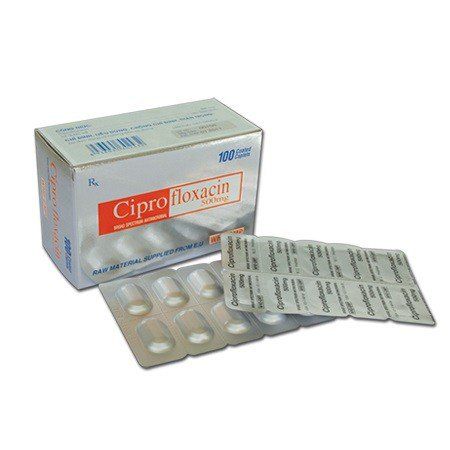This is an automatically translated article.
Ciprofloxacin is a fluoroquinolone antibiotic used in the treatment of respiratory, urinary, and genital infections,... Refer to the article below to know how to use Ciprofloxacin properly.
1. What is Ciprofloxacin?
Ciprofloxacin is an antibiotic belonging to the fluoroquinolone group. Dosage forms and strengths of Ciprofloxacin include:Tablets: 100 mg; 250 mg; 500 mg; 750 mg. Slow-release tablets: Ciprofloxacin usp 500 mg; Ciprofloxacin 1g. Oral emulsion: 250 mg/5 ml; 500 mg/5 ml Infusion: 200 mg/100 ml; 400mg/200ml. Injections for intravenous infusion: 10 mg/ml Eye drops: 0.3%. 0.2% ear drops; 0.3%.
2. Indications of Ciprofloxacin
Ciprofloxacin is indicated for use in severe infections:
Upper urinary tract infections, lower urinary tract infections. Gonorrhea has no complications. Chronic prostatitis Bacterial infections of the skin, soft tissues, bones. Enteritis, severe bacterial infection. Prevention of meningococcal disease. Prophylaxis of gram-negative infections in immunocompromised patients. Severe nosocomial infections, sepsis, treatment of infections in immunocompromised patients.
3. Contraindications of Ciprofloxacin
Ciprofloxacin is contraindicated in the following subjects:
People with a history of hypersensitivity to Ciprofloxacin and other Quinolones. Pregnant women and lactation period.
4. How to take Ciprofloxacin
How to use: take medicine 2 hours after meals, should drink with plenty of water.
Dosage in adults
Lower urinary tract infections: 100mg × 2 times/day. Upper urinary tract infections: 250 – 500mg × 2 times / day. Uncomplicated gonorrhea: 500mg, single dose. Chronic prostatitis: 500mg × 2 times/day. Skin, soft tissue, bone infections: 500 - 700mg × 2 times/day. Severe infectious enteritis: Treatment dose: 500mg × 2 times / day; Prophylactic dose: 500mg × 1 time / day. Prevention of meningococcal diseases: Adults and children over 20 kg: 500 mg, single dose Children under 20 kg: 250 mg, single dose or 20 mg/kg/day Prevention of Gram-negative infections in patients with impaired Immunity: 250 - 500mg × 2 times / day. Severe nosocomial infections, sepsis, treatment of infections in immunocompromised patients: 500-700mg × 2 times/day.
5. Ciprofloxacin side effects
Some common undesirable effects when taking Ciprofloxacin such as: Nausea, vomiting, diarrhea, abdominal pain, temporary increase in the concentration of Transaminases.
Less common side effects such as: Headache, drug fever, eosinophilia, polymorphonuclear leukopenia, lymphocytopenia, anemia, thrombocytopenia, tachycardia, agitation, dyspepsia , rash, pruritus, superficial phlebitis.
6. Precautions when using Ciprofloxacin
Ciprofloxacin should be used with caution in patients with a history of seizures or central nervous system disorders, people with impaired liver and kidney function, glucose 6 phosphate dehydrogenase deficiency, and myasthenia gravis.Long-term use of Ciprofloxacin may cause overgrowth of bacteria that are not sensitive to the drug. It is necessary to monitor the patient and make regular antibiotics to have appropriate treatment measures.
Taking Ciprofloxacin can cause tests for Mycobacterium tuberculosis to be negative.
The drug can cause side effects such as dizziness, affecting driving, operating machinery.
Pregnant women: Ciprofloxacin should only be used in severe infections for which there is no alternative antibiotic.
Lactating women: Ciprofloxacin should not be used by nursing mothers. If the mother must take the drug, she must stop breastfeeding.
Tendonitis or tendon rupture has been reported with Ciprofloxacin. This risk is increased when ciprofloxacin is used concomitantly with corticosteroids, organ transplant recipients, and patients over 60 years of age. Treatment with ciprofloxacin should be discontinued if the patient develops pain, swelling, and rupture of the tendon. When taking ciprofloxacin, it is recommended to avoid strenuous activity, heavy exercise because of the increased risk of tendon rupture.
When treated with Ciprofloxacin, patients should avoid exposure to sunlight when the sun is strong and bright lights with high power. Ciprofloxacin should be used with caution in the elderly because of the increased risk of QT prolongation.
Above are the uses and doses of Ciprofloxacin. Patients need to carefully read the instructions for use, consult a doctor / pharmacist before using to ensure safety and maximize the effectiveness of treatment.
Please dial HOTLINE for more information or register for an appointment HERE. Download MyVinmec app to make appointments faster and to manage your bookings easily.













